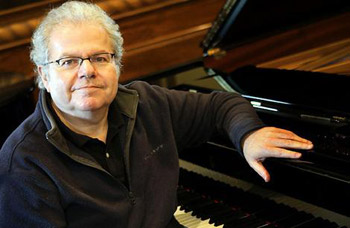by Mike Telin

On Friday, November 3 at 8:00 pm at Severance Hall, Emanuel Ax will perform Beethoven’s Piano Concerto No. 1 with The Cleveland Orchestra under the direction of Vladimir Ashkenazy. The program, which also includes Elgar’s Serenade and the Enigma Variations, will be repeated on Saturday the 4th at 8:00 pm and Sunday the 5th at 3:00 pm. Tickets are available online.
Ax made his Cleveland Orchestra debut on January 9, 1976 performing Liszt’s Second Concerto under the direction of Lorin Maazel, and since that time the pianist has appeared as concerto soloist 65 times for subscription concerts and on 10 occasions during Orchestra tours. He gave the world premiere of John Adams’ Century Rolls with Christoph von Dohnányi in September of 1997, and recorded the work with Dohnányi and the Orchestra in 1999 on the Nonesuch/Elektra label. Ax was the featured soloist for TCO’s 2008 and 2016 Gala Benefit concerts and gave solo recitals in Severance Hall as part of the Great Performer series in 1985, 1988, and 1991.
Ax said that he has “endless” remembrances of his times with the Orchestra. “When I was at Juilliard I worked as a studio accompanist for Oscar Shumsky, who was one of the violin teachers. I also did that for Dorothy DeLay and Leonard Rose — that’s how you made money when you were a student. Philip Setzer from the Emerson Quartet was one of Oscar’s students, so we are very old friends. The first time I came to play with Cleveland both of Phil’s parents were in the Orchestra, and I stayed at their house,” the pianist recalled. “The idea of being onstage with the Orchestra I heard so often as a student was mind-blowing. During the Dohnányi years I was there pretty often — we did all of the Beethoven concertos, and the two Brahms concertos both at Severance and on tour. We also premiered the John Adams, so this Orchestra has been a very rich part of my musical life, both as a performer and as a listener.”
Ax described Beethoven’s First Concerto as a spacious work not unlike the composer’s Opus 2 sonatas. “I think that as he goes on through life, his music gets more tight. But there’s a lot of difficult stuff in this concerto. Beethoven was obviously the most amazing pianist of his time. I’m sure there were things that people could not believe were being done on the piano. He was especially good at broken octaves. He was also good at thirds — he must have been because that’s what you see in his early music. Another specialty of his was the octave glissando.”
The pianist said the slow movement is “unbelievably special,” and of a “different world” from the first. “I think he intends that both in the key relationship — the idea of the enharmonic third going down from C major to A-flat — and in its reflective, almost romantic feeling. Again, it’s very expansive. And there’s a wonderful duet with the clarinet.”
When asked about the catchy tune of the third movement, he said with a laugh, “That theme is very hard. You have to find a weird fingering for it. There’s that little hop that the strings can do by changing bows, but pianists need to find a way of doing that, so I try my best.”
Although the performer has several options when choosing a cadenza, Ax is partial to Beethoven’s longer one because it is an inspired improvisation by the composer. “He may have worked on it and written it down, but I’m sure that the first time he did it, it was kind of an improvisation. Apparently, people of the time said that when Beethoven improvised they were in tears. Of all the things that he did exceptionally well, the most amazing was his improvisational ability. So I can’t help but play that cadenza. It’s just so great.”
Published on ClevelandClassical.com October 30, 2017.
Click here for a printable copy of this article



